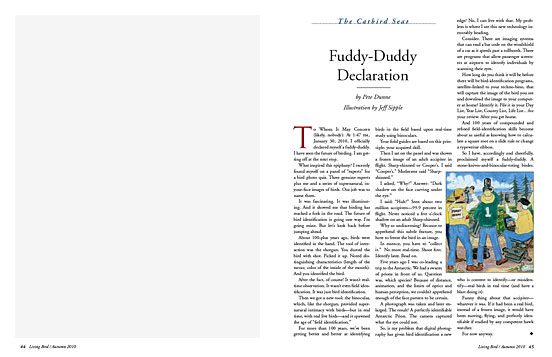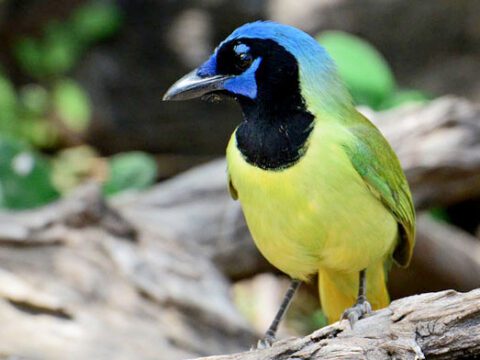The Catbird Seat: Fuddy-Duddy Declaration
by Pete Dunne; Illustration by Jeff Sipple
October 15, 2010
To Whom It May Concern (likely, nobody): At 1:47 P.M., January 30, 2010, I officially declared myself a fuddy-duddy. I have seen the future of birding. I am getting off at the next stop.
What inspired this epiphany? I recently found myself on a panel of “experts” for a bird photo quiz. Three genuine experts plus me and a series of supernatural, in-your-face images of birds. Our job was to name them.
It was fascinating. It was illuminating. And it showed me that birding has reached a fork in the road. The future of bird identification is going one way. I’m going mine. But let’s look back before jumping ahead.
About 100-plus years ago, birds were identified in the hand. The tool of interaction was the shotgun. You dusted the bird with shot. Picked it up. Noted distinguishing characteristics (length of the tarsus; color of the inside of the mouth). And you identified the bird.
After the fact, of course! It wasn’t real-time observation. It wasn’t even field identification. It was just bird identification.
Then we got a new tool: the binocular, which, like the shotgun, provided supernatural intimacy with birds—but in real time, with real live birds—and it spawned the age of “field identification.”
For more than 100 years, we’ve been getting better and better at identifying birds in the field based upon real-time study using binoculars.
Your field guides are based on this principle: your acquired skill.
Then I sat on the panel and was shown a frozen image of an adult accipiter in flight. Sharp-shinned or Cooper’s. I said “Cooper’s.” Moderator said “Sharp-shinned.”
I asked, “Why?” Answer: “Dark shadow on the face curving under the eye.”
I said: “Huh?” Seen about two million accipiters—99.9 percent in flight. Never noticed a five o’clock shadow on an adult Sharp-shinned.
Why so undiscerning? Because to apprehend this subtle feature, you have to freeze the bird in an image.
In essence, you have to “collect it.” No more real-time. Shoot first. Identify later. Read on.
Five years ago I was co-leading a trip to the Antarctic. We had a swarm of prions in front of us. Question was, which species? Because of distance, animation, and the limits of optics and human perception, we couldn’t apprehend enough of the face pattern to be certain.
A photograph was taken and later enlarged. The result? A perfectly identifiable Antarctic Prion. The camera captured what the eye could not.
So, is my problem that digital photography has given bird identification a new edge? No, I can live with that. My problem is where I see this new technology inexorably heading.
Consider. There are imaging systems that can read a bar code on the windshield of a car as it speeds past a tollbooth. There are programs that allow passenger screeners at airports to identify individuals by scanning their eyes.
How long do you think it will be before there will be bird-identification programs, satellite-linked to your techno-bino, that will capture the image of the bird you see and download the image to your computer at home? Identify it. File it in your Day List, Year List, County List, Life List…for your review. After you get home.
And 100 years of compounded and refined field-identification skills become about as useful as knowing how to calculate a square root on a slide rule or change a typewriter ribbon.
So I have, accordingly and cheerfully, proclaimed myself a fuddy-duddy. A stone-knives-and-binocular-toting birder, who is content to identify—or misidentify— real birds in real time (and have a blast doing it).
Funny thing about that accipiter— whatever it was. If it had been a real bird, instead of a frozen image, it would have been moving, flying, and perfectly identifiable if studied by any competent hawk watcher.
For now anyway.
All About Birds
is a free resource
Available for everyone,
funded by donors like you
American Kestrel by Blair Dudeck / Macaulay Library








